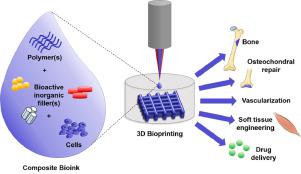Acta Biomaterialia ( IF 9.4 ) Pub Date : 2020-07-02 , DOI: 10.1016/j.actbio.2020.06.040 Susanne Heid 1 , Aldo R Boccaccini 1

|
The growing demand for personalized implants and tissue scaffolds requires advanced biomaterials and processing strategies for the fabrication of three-dimensional (3D) structures mimicking the complexity of the extracellular matrix. During the last years, biofabrication approaches like 3D printing of cell-laden (soft) hydrogels have been gaining increasing attention to design such 3D functional environments which resemble natural tissues (and organs). However, often these polymeric hydrogels show poor stability and low printing fidelity and hence various approaches in terms of multi-material mixtures are being developed to enhance pre- and post-printing features as well as cytocompatibility and post-printing cellular development. Additionally, bioactive properties improve the binding to the surrounding (host) tissue at the implantation site. In this review we focus on the state-of-the-art of a particular type of heterogeneous bioinks, which are composed of polymeric hydrogels incorporating inorganic bioactive fillers. Such systems include isotropic and anisotropic silicates like bioactive glasses and nanoclays or calcium-phosphates like hydroxyapatite (HAp), which provide in-situ crosslinking effects and add extra functionality to the matrix, for example mineralization capability. The present review paper discusses in detail such bioactive composite bioink systems based on the available literature, revealing that a great variety has been developed with substantially improved bioprinting characteristics, in comparison to the pure hydrogel counterparts, and enabling high viability of printed cells. The analysis of the results of the published studies demonstrates that bioactive fillers are a promising addition to hydrogels to print stable 3D constructs for regeneration of tissues. Progress and challenges of the development and applications of such composite bioink approaches are discussed and avenues for future research in the field are presented.
Statement of Significance
Biofabrication, involving the processing of biocompatible hydrogels including cells (bioinks), is being increasingly applied for developing complex tissue and organ mimicking structures. A variety of multi-material bioinks is being investigated to bioprint 3D constructs showing shape stability and long-term biological performance. Composite hydrogel bioinks incorporating inorganic bioreactive fillers for 3D bioprinting are the subject of this review paper. Results reported in the literature highlight the effect of bioactive fillers on bioink properties, printability and on cell behavior during and after printing and provide important information for optimizing the design of future bioinks for biofabrication, exploiting the extra functionalities provided by inorganic fillers. Further functionalization with drugs/growth factors can target enhanced printability and local drug release for more specialized biomedical therapies.
中文翻译:

推进使用活性填料进行3D生物打印的生物墨水的评论。
对个性化植入物和组织支架的需求不断增长,需要先进的生物材料和加工策略来制造可模仿细胞外基质复杂性的三维(3D)结构。在过去的几年中,诸如带有细胞(软)水凝胶的3D打印的生物制造方法越来越受到人们的关注,以设计类似于天然组织(和器官)的3D功能环境。然而,这些聚合物水凝胶常常显示出差的稳定性和低的印刷保真度,因此就多材料混合物而言,正在开发各种方法以增强印刷前和印刷后的特性以及细胞相容性和印刷后细胞的发育。另外,生物活性特性改善了在植入部位与周围(宿主)组织的结合。在这篇综述中,我们着眼于特定类型的异质生物墨水的最新技术,这些墨水由掺有无机生物活性填料的聚合物水凝胶组成。这样的系统包括各向同性和各向异性的硅酸盐(如生物活性玻璃)和纳米粘土或磷酸钙(如羟基磷灰石)(HAp),它们可提供原位交联效应,并为基质增加额外的功能,例如矿化能力。本篇综述论文根据现有文献详细讨论了这种生物活性复合生物墨水系统,揭示了与纯水凝胶相比,已开发出具有显着改善的生物印刷特性的多种产品,并使印刷细胞具有较高的生存能力。对已发表研究结果的分析表明,生物活性填料是水凝胶有望印刷出稳定的3D构建体以再生组织的有前途的补充。讨论了这种复合生物墨水方法的开发和应用的进展和挑战,并提出了该领域未来研究的途径。
重要声明
涉及加工包括细胞(生物墨水)在内的生物相容性水凝胶的生物加工正越来越多地用于开发复杂的组织和模仿器官的结构。正在研究多种材料的多种生物墨水,以对3D构建体进行生物打印,以显示形状稳定性和长期生物性能。包含无机生物反应性填料的3D生物打印复合水凝胶生物油墨是本篇综述的主题。文献中报道的结果突出了生物活性填料对生物油墨性能,可印刷性以及印刷过程中和印刷后的细胞行为的影响,并为利用无机填料提供的额外功能性优化未来用于生物制造的生物油墨的设计提供了重要信息。











































 京公网安备 11010802027423号
京公网安备 11010802027423号